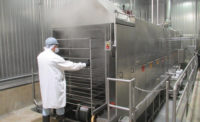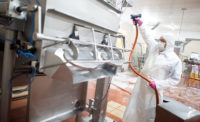Sanitizing and cleaning together ensure safety

Sanitation and cleaning in meat processing plants are both required to ensure a clean environment. Cleaning is done by picking up debris from processing surfaces and discarding it, then typically using water to remove smaller debris, applying a detergent, scrubbing or washing areas, and then rinsing. Sanitizing is the next step in the process that aims to eliminate microbiological contaminants.
“While cleaning is important, it does not create a sanitary environment when completed without a sanitation step,” explains Abbey Davidson, outreach specialist at the American Association of Meat Processors, Elizabethtown, Pa. “Vice versa, surfaces cannot be sanitized effectively if cleaning is not completed. I do believe that processors create an environment where employees are trained on what to do to complete these tasks, but I firmly believe you cannot train enough, and the ‘why’ behind the sequence of these steps and the importance of each can always be reiterated.”
Each processing environment creates different challenges too.
“Processing environments where ready-to-eat product is produced would really need to focus on food contact surfaces, but just as importantly focus on non-food contact surfaces to ensure Listeria monocytogenes is not present or cannot proliferate in the plant,” Davidson says. “For processors where both raw and ready-to-eat product are produced in the same area, it is vital that a cleanup occurs between each type, as pathogens of concern can cross-contaminate each other type. Most importantly, raw meat associated pathogens could contaminate ready-to-eat products.”
The important takeaways for sanitation crews, though, are to make sure they do not work if they have a foodborne illness, to ask questions if they don’t understand something, and to clean and sanitize processing areas by following their company’s procedures.
The major key tips and practices for sanitation supervisors to remind their teams to wear proper gear during cleaning and to ensure the chemicals that are being used are at the appropriate concentration and checked frequently. Additionally, Davidson suggests completing an inspection of the area after cleaning and sanitizing is complete so that any area that were missed can be properly treated while the cleaning equipment is still out.
If processors are receiving sanitation chemicals from an international source, there is a chance of running into supply issues. Additionally, if the same sanitizer is used in a facility for a prolonged period of time, there is a chance that any present microbes may develop a resistance to the sanitizer, making it ineffective.
“Completing aerobic plate count tests would demonstrate if the cleaning and sanitizing practices are effective at the facility,” Davidson explains. “Additionally, a chlorine-based sanitizer would be a great backup if chemical sources are low, or if microbial resistance is present. This could be an unscented bleach, mixed to 100 PPM and applied to equipment after cleaning is complete.”
Recently, ozone sanitation has been a technology that has been useful in improving sanitation in facilities. “There originally was a significant cost to ozone sanitation and there still may be, but there are now ways to make it cheaper on the facility,” Davidson adds.
ARTWORK: Something like https://www.gettyimages.com/detail/photo/spraying-disinfection-on-surface-royalty-free-image/1213050764?adppopup=true
Looking for a reprint of this article?
From high-res PDFs to custom plaques, order your copy today!









